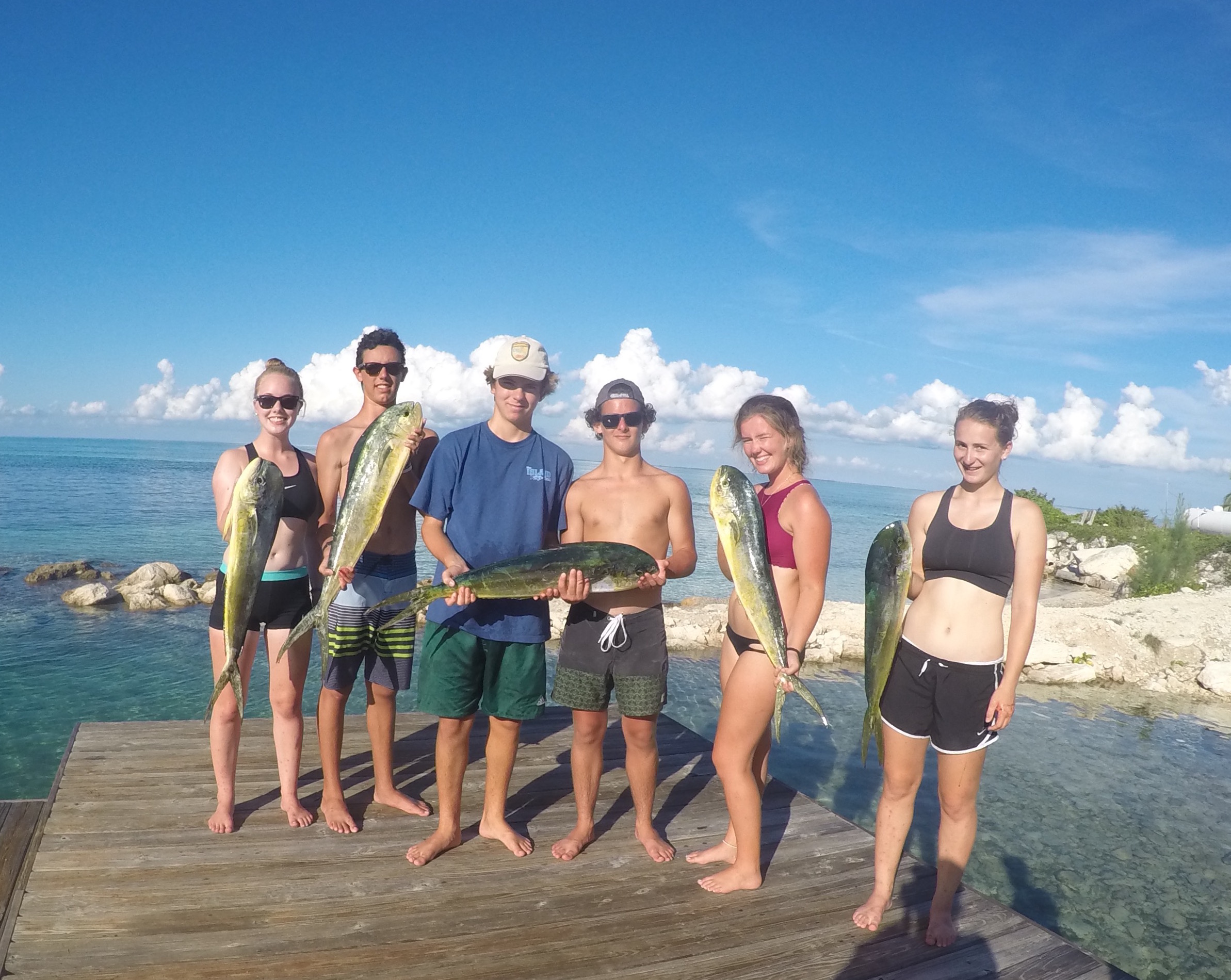
The sun beats down on the decks of the “Dave and Di” as the plastics research team pulls out of Boathouse Cut. The first stop is the marina store, not for its assortment of snacks that we’ve all grown to crave over the past month, but for the slightly less delectable squid to use as bait for our afternoon of fishing. With a cooler full of ice and bait, a variety of lures, four trolling rods, and the good old plastic trawl, we follow the curving coastline of Southern Eleuthera and then make a beeline for the Exuma Sound. Once we get past the wall, which drops off thousands of feet, we start looking for signs of life. This includes flying fish, birds hunting, and any other fishing boats. We continue out at top speed until we get about 25 miles off the coast, or a third of the way into the Exuma Sound. The trolling rods get equipped with squids and the “Dave and Di” putters along, bobbing up and down on the soft yet developing swells beneath. We all sit lazily at the bow, enjoying the warmth of the breeze.
With the whiz of a rod, all hands are immediately on deck. Not even 30 seconds after the initial fish-on, a second rod goes off, and then a third, and then the fourth. We scramble to grab hold of a rod, trying to keep the tension needed to keep the fish on the line. The iconic darts of lime green, neon yellow, and electric blue that identify mahi mahi (dolphinfish) flash through the clear water. Their sheer strength and power is evident in their multiple feet-high leaps out of the ocean. These fish are not alone. The four fish on the lines are accompanied by the rest of their school that is made up of at least six other mahi mahi. A flurry of excited shouts echo as we struggle to pull the fish up on deck in order to get more on the line. The fish that are of proper size, we save for later research, but the majority of the fish caught are strictly catch-and-release.
My first instinct throughout all of this chaos is to grab my GoPro to document the experience for fun as well as for research purposes. I make sure to snap photos of the fishing action on deck as well as the equally crazy action going on beneath the surface. However, I too got my chance to reel in a fish of my own. I grabbed hold of a rod that a mahi had just been released from and send a soaring cast into the blue. Attempting the jerking motions with the rod that I’d observed other group members doing, I did my best to allure a potential catch. When a fish hooked on, my entire body lurched forward with the pure force of the tug. I began to reel in my catch, keeping the tension on the fish all the while. After the madness, our total catch count was 12 mahi mahi, 5 of which we kept for our research project.

Why is the plastics research team out sport fishing you may ask? Our plastics study for this semester has three main objectives: to quantify plastics, especially micro-plastics, in the Exuma Sound, to catch and dissect the stomachs of pelagic fish to see if fish are consuming plastics, and if this is the case, if the fish are preferentially or incidentally feeding on the plastics. In order to conduct the latter two components of our study, it is necessary that we actually have fish from the Exuma Sound to dissect. There is a critical need for our micro-plastic study because the ingestion of plastics by fish has potential deadly effects on them. When a fish consumes micro-plastic, the plastic can stick to the fish’s stomach and make them feel full, thus acting as a “filler.” This means that the fish will then not eat actual food and can starve.
The Exuma Sound is a good place for this study on plastics because it may be a sink, meaning a place for plastics to come in and never leave. This is because the sound is restricted due to the surrounding islands, because of the way the currents run here, and the way that the Atlantic gyre may be driving plastics right to this area. Though our study is not focusing on it, it is also important to note that pelagic sport fish in the Bahamas play a large role in the economy and are being frequently caught, sold, and consumed by humans. The health effects of consuming micro-plastics through fish are still being studied, however, the outcome does not look good.
Studies like the one we are conducting over the course of this semester are important for many more reasons then an awesome afternoon of fishing. The research that is being done can be added to the work that other scientists have done so that a broader background can be established on the topic and so that there is an increase in what we know about it. Especially with plastics, if we can figure out what the relationship between fish and micro-plastics is in the Exuma Sound, future studies can use our results to conduct studies relating more directly to humans. It also gives me as well as the five other Island School students in my group the incredible opportunity to be a part of a real scientific study and gain insight into what it really means to be a researcher in this field. An afternoon boating in thousands of feet deep water, catching sport fish, and using it all for research that really matters. Just another day at the Island School.